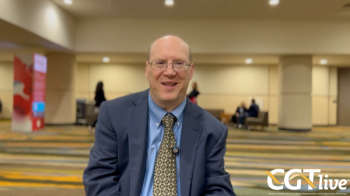
John Leonard, PhD, on RNA-Targeting Gene Therapy for ALS, DMD
The chief scientific officer of LocanaBio discussed preclinical research presented at ASGCT 2023.
“I think this is the first in vivo demonstration of dual targeting in the context of a disease where we know that the pathology is driven from both sense and antisense transcripts. And we do this without knocking down the wild type expression of C9orf, which people are concerned about for haplo-insufficiency as a potential contributor to [ALS]. So, that work I think looks really good.We're now focused on delivery of those constructs. So,what's the best capsule? And what's the best route of administration? But from a targeting perspective, and from a safety perspective, the data looks quite compelling.”
Cas13d-MT, LocanaBio’s preclinical CRISPR/cas9-based, adeno-associated virus vector (AAV) gene therapy, decreased biomarkers associated with C9orf72 amyotrophic lateral sclerosis (ALS). New in vivo and in vitro research showed that the therapy led to a significant reduction of both sense and antisense hexanucleotide repeat expansioncontaining RNAs, a 50-60% decrease in poly-GP dipeptide repeat proteins, and maintenance of total C9orf72 mRNA levels. The transgene showed sustained expression with no signs of toxicity at 6 to 8 weeks after treatment.
These data were presented at the
REFERENCES
1. Roth DM, Chew J, Bradford H, et al. Cas13d multi-targeting efficiently targets sense and antisense HRE containing toxic RNAs and poly-GP DPR in C9ALS patient cells and in C9-BAC500 mouse model. Presented at: ASGCT 2023 Annual Meeting; May 16-20; Los Angeles, California. Abstract #811.
2. Markmiller RL, Nachtrab G, Geddes C, et al. Small nuclear RNA-mediated exon 51 skipping AAV9 gene therapy for the treatment of Duchenne muscular dystrophy. Presented at: ASGCT 2023 Annual Meeting; May 16-20; Los Angeles, California. Abstract #1198.
Newsletter
Stay at the forefront of cutting-edge science with CGT—your direct line to expert insights, breakthrough data, and real-time coverage of the latest advancements in cell and gene therapy.

















































